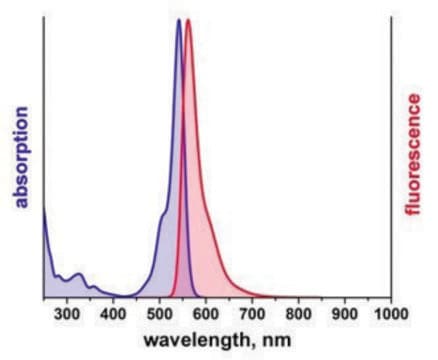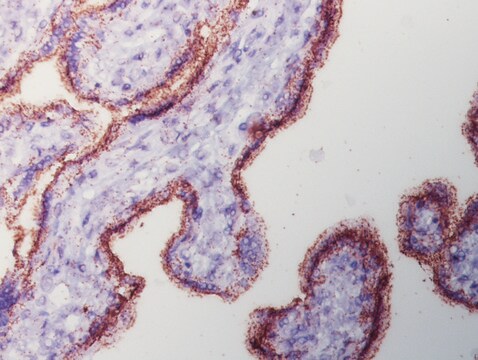추천 제품
제품 라인
Duolink®
Quality Level
기술
proximity ligation assay: suitable
형광
λex 554 nm; λem 576 nm (Cyanine 3; Zeiss Filter set 20)
적합성
suitable for fluorescence
배송 상태
dry ice
저장 온도
−20°C
애플리케이션
Duolink®proximity ligation assay(PLA®) allows for endogenous detection of protein interactions, post translational modifications, and protein expression levels at the single molecule level in fixed cells and tissue samples.
Follow the Duolink® In Situ Fluorescence Protocolto use this product. A set of short instructionsis also available.
Visit our Duolink® PLA Resource Center for information on how to run a Duolink® experiment, applications, troubleshooting, and more.
To perform a complete Duolink® PLA in situ experiment you will need two primary antibodies (PLA, IHC, ICC or IF validated) that recognize two target epitopes. Other necessary reagents include a pair of PLA probes from different species (one PLUS and one MINUS), detection reagents, wash buffers, and mounting medium. Note that the primary antibodies must come from the same species as the Duolink® PLA probes. Analysis is carried out using standard immunofluorescence assay equipment.
Follow the Duolink® In Situ Fluorescence Protocolto use this product. A set of short instructionsis also available.
Visit our Duolink® PLA Resource Center for information on how to run a Duolink® experiment, applications, troubleshooting, and more.
To perform a complete Duolink® PLA in situ experiment you will need two primary antibodies (PLA, IHC, ICC or IF validated) that recognize two target epitopes. Other necessary reagents include a pair of PLA probes from different species (one PLUS and one MINUS), detection reagents, wash buffers, and mounting medium. Note that the primary antibodies must come from the same species as the Duolink® PLA probes. Analysis is carried out using standard immunofluorescence assay equipment.
Specificity
Orange fluorescence detection reagents are often used with Cyanine 3 filter.
Application Note
Two primary antibodies raised in different species are needed. Test your primary antibodies (IgG-class, mono- or polyclonal) in a standard immunofluorescence (IF), immunohistochemistry (IHC) or immunocytochemistry (ICC) assay to determine the optimal fixation, blocking, and titer conditions. Duolink® in situ reagents are suitable for use on fixed cells, cytospin cells, cells grown on slide, formalin-fixed, paraffin embedded (FFPE), or tissue (fresh or frozen). No minimum number of cells is required.
Let us do the work for you, learn more about our Custom Service Program to accelerate your Duolink® projects
View full Duolink® product list
Orange fluorescence detection reagents are often used with Cyanine 3 filter.
Application Note
Two primary antibodies raised in different species are needed. Test your primary antibodies (IgG-class, mono- or polyclonal) in a standard immunofluorescence (IF), immunohistochemistry (IHC) or immunocytochemistry (ICC) assay to determine the optimal fixation, blocking, and titer conditions. Duolink® in situ reagents are suitable for use on fixed cells, cytospin cells, cells grown on slide, formalin-fixed, paraffin embedded (FFPE), or tissue (fresh or frozen). No minimum number of cells is required.
Let us do the work for you, learn more about our Custom Service Program to accelerate your Duolink® projects
View full Duolink® product list
특징 및 장점
- No overexpression or genetic manipulation required
- High specificity (fewer false positives)
- Single molecule sensitivity due to rolling circle amplification
- Relative quantification possible
- No special equipment needed
- Quicker and simpler than FRET
- Increased accuracy compared to co-IP
- Publication-ready results
성분
This product is comprised of the following:
Not included in Detection kit:
Primary antibodies, PLA probes, wash buffers, mounting medium
- 5x Ligation - Contains oligonucleotides that hybridize to the PLA probes and all components needed for ligation except the Ligase
- 1x Ligase (1 unit/μL)
- 1x Polymerase (10 units/μL)
- 5x Amplification Orange - Contains all components needed for Rolling Circle Amplification (RCA) except the Polymerase. It also contains oligonucleotide probes labeled with a fluorophore that hybridize to the RCA product.
Not included in Detection kit:
Primary antibodies, PLA probes, wash buffers, mounting medium
법적 정보
Duolink is a registered trademark of Merck KGaA, Darmstadt, Germany
PLA is a registered trademark of Merck KGaA, Darmstadt, Germany
신호어
Danger
유해 및 위험 성명서
예방조치 성명서
Hazard Classifications
Resp. Sens. 1
Storage Class Code
10 - Combustible liquids
시험 성적서(COA)
제품의 로트/배치 번호를 입력하여 시험 성적서(COA)을 검색하십시오. 로트 및 배치 번호는 제품 라벨에 있는 ‘로트’ 또는 ‘배치’라는 용어 뒤에서 찾을 수 있습니다.
이미 열람한 고객
Tomokazu Sumida et al.
Nature immunology (2018-10-31)
Foxp3+ regulatory T cells (Treg cells) are the central component of peripheral immune tolerance. Whereas a dysregulated Treg cytokine signature has been observed in autoimmune diseases, the regulatory mechanisms underlying pro- and anti-inflammatory cytokine production are elusive. Here, we identify
Kan V Lu et al.
Cancer cell, 22(1), 21-35 (2012-07-14)
Inhibition of VEGF signaling leads to a proinvasive phenotype in mouse models of glioblastoma multiforme (GBM) and in a subset of GBM patients treated with bevacizumab. Here, we demonstrate that vascular endothelial growth factor (VEGF) directly and negatively regulates tumor
Birgitte B Olsen et al.
BMC molecular biology, 13, 7-7 (2012-03-13)
The DNA-dependent protein kinase (DNA-PK) is a nuclear complex composed of a large catalytic subunit (DNA-PKcs) and a heterodimeric DNA-targeting subunit Ku. DNA-PK is a major component of the non-homologous end-joining (NHEJ) repair mechanism, which is activated in the presence
Ivan Matic et al.
Molecular cell, 39(4), 641-652 (2010-08-28)
Reversible protein modification by small ubiquitin-like modifiers (SUMOs) is critical for eukaryotic life. Mass spectrometry-based proteomics has proven effective at identifying hundreds of potential SUMO target proteins. However, direct identification of SUMO acceptor lysines in complex samples by mass spectrometry
Pengcheng Zhu et al.
Cancer cell, 19(3), 401-415 (2011-03-15)
Cancer is a leading cause of death worldwide. Tumor cells exploit various signaling pathways to promote their growth and metastasis. To our knowledge, the role of angiopoietin-like 4 protein (ANGPTL4) in cancer remains undefined. Here, we found that elevated ANGPTL4
문서
Find Duolink references based on the type of method used, post translational modification detected, and research focus.
관련 콘텐츠
Applications to detect, quantify and visualize protein-protein interactions, post-translational modifications and low expression protein detection using proximity ligation assay
자사의 과학자팀은 생명 과학, 재료 과학, 화학 합성, 크로마토그래피, 분석 및 기타 많은 영역을 포함한 모든 과학 분야에 경험이 있습니다..
고객지원팀으로 연락바랍니다.








